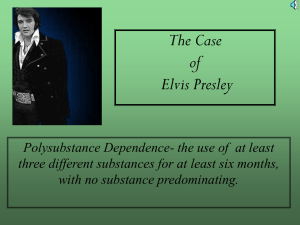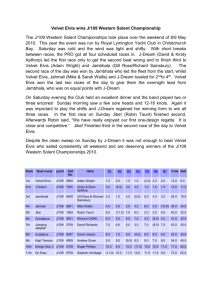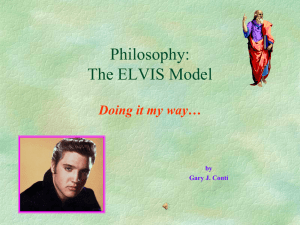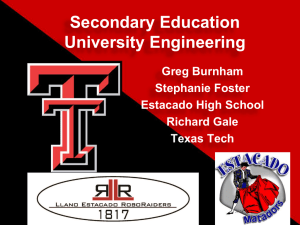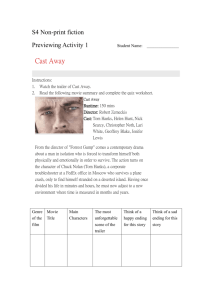EDUCATIONAL LABORATORY VIRTUAL INSTRUMENTATION
advertisement
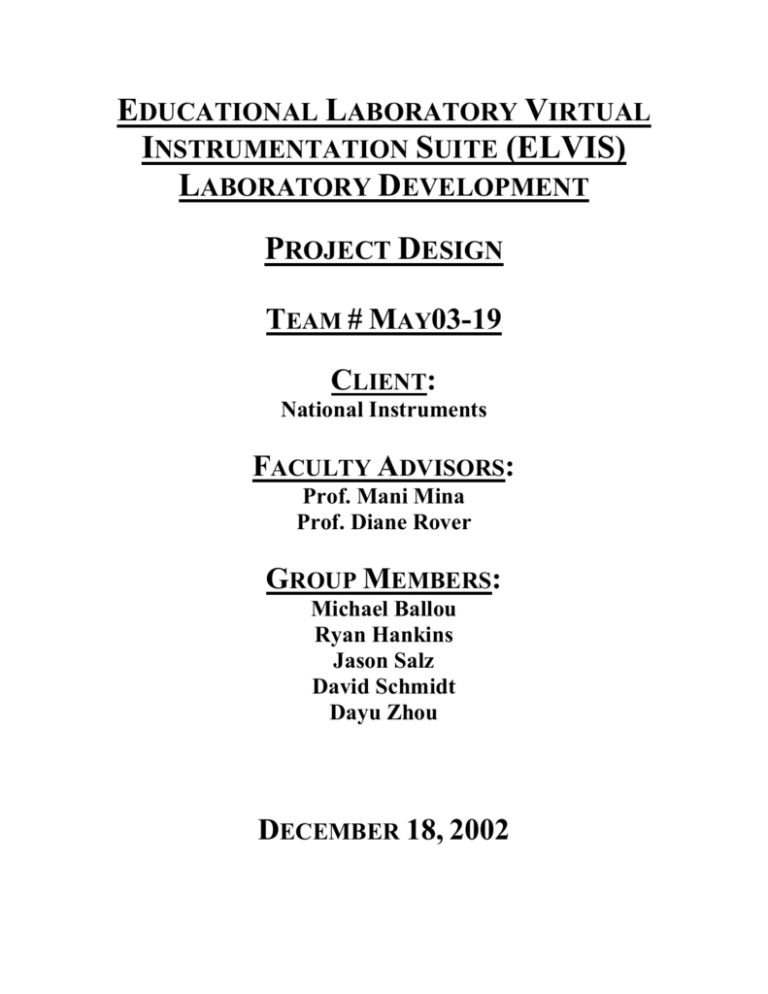
EDUCATIONAL LABORATORY VIRTUAL INSTRUMENTATION SUITE (ELVIS) LABORATORY DEVELOPMENT PROJECT DESIGN TEAM # MAY03-19 CLIENT: National Instruments FACULTY ADVISORS: Prof. Mani Mina Prof. Diane Rover GROUP MEMBERS: Michael Ballou Ryan Hankins Jason Salz David Schmidt Dayu Zhou DECEMBER 18, 2002 Table Of Contents List Of Figures ................................................................................................................................ ii List Of Tables ................................................................................................................................ iii Abstract ........................................................................................................................................... 1 Acknowledgement .......................................................................................................................... 1 Definition of Terms......................................................................................................................... 1 1 Introduction ................................................................................................................................. 2 1.1 General Background .................................................................................................... 2 1.2 Technical Problems ...................................................................................................... 3 1.3 Operating Environment ................................................................................................ 3 1.4 Intended User ............................................................................................................... 3 1.5 Assumptions and Limitations ...................................................................................... 3 2 Design Requirements .................................................................................................................. 4 2.1 Design Objectives ........................................................................................................ 4 2.2 Functional Requirements ............................................................................................. 5 2.3 Design Constraints ....................................................................................................... 5 2.4 Measurable Milestones ................................................................................................ 6 3 End-Product Description ............................................................................................................. 7 4 Approach and Design .................................................................................................................. 8 4.1 Technical Approaches .................................................................................................. 8 4.2 Technical Design ......................................................................................................... 8 4.3 Testing Description .................................................................................................... 10 4.4 Risks and Risk Management ...................................................................................... 10 4.5 Recommendation for Continued Work ...................................................................... 10 5 Financial Budget ....................................................................................................................... 11 6 Personnel Effort Budget ............................................................................................................ 11 7 Project Schedule........................................................................................................................ 12 8 Project Team Information ......................................................................................................... 13 9 Summary ................................................................................................................................... 14 10 References ............................................................................................................................... 14 i List Of Figures Figure 1.1 – ELVIS ......................................................................................................................... 2 Figure 3.1 – Current Lab System .................................................................................................... 7 Figure 3.2 – ELVIS Lab System ..................................................................................................... 7 Figure 7.1 – Project Schedule ....................................................................................................... 12 ii List Of Tables Table 5.1 – Financial Budget ........................................................................................................ 11 Table 6.1 – Personnel Effort Budget............................................................................................. 11 iii Abstract The labs of several electrical engineering courses at Iowa State University are being considered for an upgrade to a new data acquisition (DAQ) system. The team must become familiar enough with this system to document the conversion process of the electrical engineering labs to the new system. ELVIS in conjunction with LabVIEW will be used to collect and measure data and input the data into a computer for processing. The team will determine the instrumentation needs of a particular lab and replace the instruments functionality with an equivalent ELVIS and LabVIEW setup. The end result will be a complete set of documentation for converting future labs, as well as a demonstration of a converted lab. This project is keeping Iowa State labs on the cutting edge of technology to better prepare engineers for the future. Acknowledgement The team would like to acknowledge David Gardner and Randy Hoskin of National Instruments for providing two ELVIS systems and DAQ boards that will be used through the project. Definition of Terms o Educational Laboratory Virtual Instrumentation Suite (ELVIS) – A hardware DAQ system. o Data acquisition (DAQ) – Process of collecting and measuring electrical signals from sensors, transducers, and test probes or fixtures, and inputting them to a computer for processing. o LabVIEW - A graphical programming language used for creating test, measurement, and automation applications that has been developed by National Instruments. o Traditional laboratory instruments – Unique instruments providing different functionalities. Examples include function generators, digital multimeters and oscilloscopes. o Virtual Instruments – Software representations of traditional instruments. Virtual instruments are used to control and take readings from a hardware device capable of communicating via a DAQ card. 1 1 Introduction At Iowa State University, computer and electrical engineering students are given the opportunity to learn electrical engineering concepts through hands on work in course labs. A variety of equipment and instrumentation, such as voltage and current sources, function generators and oscilloscopes, are provided for students to test the behavior of actual electrical circuits and systems. Though exposure and familiarity to a wide variety of instruments is valuable, students often spend more time configuring instruments and manually recording data than is spent implementing circuits and analyzing the data. The ELVIS system has been designed to consolidate a variety of instruments into one functionally equivalent system and to provide a means of automatic data acquisition. 1.1 General Background The goal of this project is to convert at least one current lab to the ELVIS and LabVIEW system and to provide documentation for converting future labs. The first step is spending time working with ELVIS and LabVIEW so that the group is accustomed to the system and can work proficiently with it. At least one lab will then be converted completely to the ELVIS and LabVIEW system. The group will document the conversion process and then document the steps that need to be taken to convert future labs. Figure 1.1 – ELVIS 2 1.2 Technical Problems The major foreseeable problem that the group may encounter is a difficulty in configuring virtual instruments to behave like real life instruments. Many instruments are provided in LabVIEW and it is possible that after some trial and error a suitable virtual equivalent could be found. If that scenario is not possible then an instrument will have to be created by the group members. Technical issues with the ELVIS hardware also exist. The hardware version available to the senior design team is still in beta development. This hardware does not support either current measurement or current output. Measurement inaccuracies as high as 20% from expected values have also been observed. 1.3 Operating Environment After completion of this project, the system would most likely be used by electrical and computer engineering students while in lab. The EE 201 labs are the primary attention of the project group. Freshman students who have minimal engineering knowledge generally attend these labs, so converted labs would have to be simple so as not to confuse the user. New engineering students may also unknowingly create circuits with inputs or outputs that could damage the ELVIS hardware. 1.4 Intended User The intended user for this project is the Department of Electrical and Computer Engineering. This department can use the ELVIS and LabVIEW system developed by the project team to upgrade the current labs used for certain courses. The EE 201 lab is the primary lab to be integrated with the new ELVIS and LabVIEW system. The new system would allow for easier reading of measurements taken in the lab and can be used as a replacement for several traditional lab instruments. 1.5 Assumptions and Limitations Assumptions made while planning the project are as follows: 1. National Instruments will provide the ELVIS and DAQ hardware. 2. Virtual instruments that are used by LabVIEW and are compatible with ELVIS will be provided. 3. The group can create virtual instruments that are not provided. 4. It is assumed that the DAQ can capture all data required by the lab. 5. National Instruments will provide necessary information regarding complications with the ELVIS hardware. 6. Hardware is installed and correctly configured. 3 Possible limitations that may be encountered are as follows: 1. Functionality of virtual instruments controlled by LabVIEW may not exactly match the functionality provided by the actual instruments currently used in lab. 2. The ELVIS hardware may not be able to generate the variety of signals currently required by a lab. 3. Breadboards on which students implement circuits are somewhat expensive which could preclude them from being removed from the lab. 4. Hardware is still in the beta stage of development and does not meet all design requirements with regards to measurement accuracy. 2 Design Requirements This section contains four components- design objectives, functional requirements, design constraints, and measurable milestones. Each of these sections comprises requirements that the ELVIS project must take into account during design and are further described below. 2.1 Design Objectives Listed below are the technical challenges that must be met by the design of ELVIS. The first two items are objectives that the team must meet before beginning actual work on the project, whereas the last two are part of the end result. o Gain an understanding of National Instruments’ LabVIEW: By reading NI documentation, following LabVIEW tutorials and by hands-on experimentation, the team will become familiar with LabVIEW. o Gain an understanding of National Instruments’ ELVIS DAQ System: The team will use the ELVIS setup and associated documentation provided by NI to learn how the system works. o Provide complete documentation to convert all EE 201 labs to the ELVIS system: This is the core of the project and will consume a majority of the time. After becoming comfortable with ELVIS/LabVIEW, the group will proceed to write out the steps necessary to implement the entire EE 201 laboratory using the new system. Given the limitations of the beta version of ELVIS available to the group, some of the documentation for converting EE 201 labs may require altering the labs themselves. In cases where current measurement is required, it may be necessary to find a way to work around that measurement. 4 o Carry out the conversion of selected EE 201 labs to the ELVIS system: As a demonstration of the project, the group will attempt to implement as many of the EE 201 labs as possible using the hardware and software provided by NI. In some cases this may not be possible due to limitations in the current version of ELVIS. In such cases, the changes necessary to make ELVIS more appropriate for this project will be documented. 2.2 Functional Requirements The three requirements below specify the necessary functionality of the finished ELVIS lab setup. These goals are crucial to the success of the project. o Provide clear, concise, and accurate documentation for all EE 201 labs: The documents produced must be written in such a way that undergraduate engineering students will have no problems understanding and following the instructions. o The new system will teach the same objectives as the previous lab system: The revised labs will not be substantially changed in terms of content and concepts taught. Students will follow the same procedures but instead of using hardware and instruments, they will be able to use a computer to manipulate virtual instruments. o Provide students with a clear virtual instrument interface: The team must produce a functional computerized interface using LabVIEW that students will find intuitive and easy to use. 2.3 Design Constraints The next four items are constraints that limit the project to ensure its practicality and usefulness to the EE/CprE department. o Lab procedures must not be fundamentally changed: Conversion to the ELVIS system must not change the basic ideas of the lab. o Students should be able to complete the labs in approximately the same amount of time as with the previous system: The new ELVIS system should not require students to spend more time completing the labs. Ideally it will free up time spent fighting with poorly calibrated instruments to be used more productively. 5 o Labs must run on available computers using the donated ELVIS system: All the labs must work using typical EE/CprE lab PC hardware running Windows 2000 in conjunction with the new ELVIS system. o The system must be able to provide a virtual instrument to replace as many instruments as possible: The new ELVIS system must either utilize pre-supplied virtual instruments to implement current hardware or new virtual instruments created by the team. Any signal measurement or generation not provided by ELVIS will require a traditional lab instrument. 2.4 Measurable Milestones Below is a list of milestones by which the project’s progress and success may be gauged. The following criteria will be used to provide a relative indication of success: 100% The milestone was successfully met or exceeded. 75% The milestone was mostly met with one or more parts left unfinished. 50% A portion of the milestone was accomplished with significant sections left undone. 25% An effort was made and some progress made but mostly undone. 0% No effort made. o Analyze necessary virtual instruments: (5%) The team must determine which of the necessary virtual instruments (such as multimeters, ammeters, and oscilloscopes) are currently available and which must be created. 100% success for this milestone will be considered providing the necessary virtual instruments for the labs. Anything less will be evaluated using the percentages listed above. o Completion of LabVIEW virtual instrument interface: (40%) Completing the computer interface will allow testing of the converted labs. If the team is able to provide all the graphical interfaces for the converted labs, this milestone will be 100% successful. Providing less than this will be judged according to the above percentages. o Completion of necessary documentation: (25%) Finishing the documentation for each lab will be a major portion of the project. If all labs are fully documented the milestone will be considered successfully completed. Less than complete documentation will result in a lower percentage of success. 6 o Completion of testing: (10%) Thorough testing of the documentation for readability and accuracy is necessary. Testing of the implemented labs to ensure complete functionality is also important. If all the necessary testing is completed, the milestone will be completely met. Otherwise, completion success will be lowered according to the percentages above. o Revision: (10%) Upon testing, any errors or other problems in the documentation or labs will be resolved. This revision process will continue until the requirements for the project are met. If errors found during testing or review are not corrected, less than 100% success of this milestone will be the result. o Working demonstration of selected labs using ELVIS system: (10%) The last step of this project involves demonstrating selected EE 201 labs. If everything was successfully completed up to this point, the demonstration should proceed without problems. 100% success will be considered to be project demonstration without problems. 3 End-Product Description The basic electrical engineering laboratory EE 201 will be converted from traditional multimeter-based experiments to labs using the new ELVIS DAQ system. ELVIS will gather the data related to the test circuits and transfer the data to a computer with LabVIEW installed. Students can then use graphical interfaces generated by LabVIEW to analyze the data. With ELVIS, students are relieved of errors and problems of measuring equipment and the efficiency of laboratory education will be enhanced. Figure 3.1 – Current Lab System Figure 3.2 – ELVIS Lab System 7 4 Approach and Design This section is composed of the following sections- technical approaches, technical design, testing description, and risk and risk management. These sections describe important phases of the approaches used in the design and testing process. 4.1 Technical Approaches The primary objective of this project is to evaluate the usefulness of ELVIS in a college environment and to provide documentation that outlines the necessary steps required to use ELVIS in a lab environment. To successfully convert the existing EE 201 laboratory to make use of the ELVIS system, three major steps must be followed; namely, learning the functionalities and usages of ELVIS and LabVIEW, creating graphical interfaces using LabVIEW and providing documentation for future lab conversions. There are several resources that can be utilized to learn the functionality of ELVIS. The primary source of information will be the documentation written by NI and supplied with ELVIS. However, due to the fact that ELVIS is still in active development, the documentation may not always accurately reflect the true state of the ELVIS hardware. Technical support from National Instruments will be available to help resolve issues stemming from possible documentation inaccuracies. For select labs in the existing EE 201 lab manual, the team will create the required number of graphical interfaces for analysis with LabVIEW to provide the same functionality as the existing lab. Because the circuits to be built and tested remain unchanged, the graphical interfaces will serve the same objectives as the existing labs. Finally, the team will write a detailed documentation for TAs or technicians in the electrical engineering department on how to convert the existing electronics laboratory to the one using ELVIS. 4.2 Technical Design When reporting the actual design of the project, several major topics will be explained in detail: 1. 2. 3. 4. Working mechanism of ELVIS/LabVIEW LabVIEW code and user interfaces Capabilities and limitations of ELVIS Lab conversion documentation Working mechanism of ELVIS As stated earlier, the ELVIS hardware is still a work in progress. This adds a measure of difficulty to the work being done for this project. Every effort will be made to 8 successfully complete this project without requiring modifications to the ELVIS specifications. The original project plan stated several existing EE 201 labs would be migrated to the ELVIS system without fundamentally changing the concepts taught in lab and also to remove the need for traditional instrumentation. Due to several limitations in the current ELVIS hardware, this may no longer be an obtainable goal. For example, several EE 201 labs require students to measure current at certain points in their circuits. ELVIS does not support current measurement. Either the fundamental concept of current measurement will have to be removed, or a traditional instrument capable of current measurement will need to be used. In the final documentation outlining the procedure to convert labs to make use of ELVIS, all inherent limitations of ELVIS must be clearly explained and alternative actions provided. LabVIEW and user interfaces One of the primary advantages ELVIS has over traditional instruments is its data acquisition capabilities. The virtual instruments provided by NI to control ELVIS do a good job of recreating the look and feel of traditional instruments, but do little as far as providing users with the ability to automatically record data. Providing students with a method to visually observe circuit behavior through the use of graphs, tables and charts would be a major advantage over traditional lab instruments. NI has provided source code to the ELVIS virtual instruments. With the objective of adding value to what ELVIS has to offer, the team will extend these virtual instruments to include enhanced data capturing and visualization capabilities. Capabilities and limitations of ELVIS Through the course of this project, the team will document the enhanced capabilities of ELVIS as they are developed and also make note of inherent limitations of the system as they are discovered. An objective summary of all capabilities and limitations will be a critical component of the final project report. Those who are responsible for EE labs will base their decision whether or not to adopt ELVIS in large part on the contents of this list. Lab conversion documentation The primary goal of providing lab conversion documentation depends mainly on actually implementing the EE 201 labs using ELVIS. If the lab can be completed in a way that meets the requirements and specifications of the project, the team will then document what must be done to convert to using ELVIS. 9 4.3 Testing Description The user interface enhancements made to the ELVIS virtual instruments will need to be tested. Because the initial development will based on EE 201 labs, current EE 201 students will be contacted and asked to evaluate the ELVIS system. The team will learn what common mistakes they make and how the interface can be refined to prevent similar mistakes in the future. Finally, the document describing the lab conversion process will also need to be tested. Testing shall consist of having the team follow the directions created for the project and evaluate the effectiveness of the conversion instructions. If the conversion resulting from following the directions is not exactly what the team intended, the documentation will be revised. 4.4 Risks and Risk Management 1. The equipment is expensive. Special care must be taken in the installation process. 2. Provided with damaged or malfunctioning equipment from National Instruments. 3. A team member may be lost from the project. If this occurs, the only option will be to finish the project with the remaining team members. 4. Delayed delivery of equipment from National Instruments. One risk not taken into consideration earlier was that ELVIS might be fundamentally insufficient for a college level lab environment. Some of the deficiencies may be minimized or fixed later but for now this is a significant risk. Risk management has otherwise progressed according to the original plan. There is also a risk that other unknown deficiencies will be discovered in the future and these may prevent the team from successfully completing the project. 4.5 Recommendation for Continued Work Based on what the team has seen thus far of the capabilities of ELVIS, it is recommended that the project be continued through to the completion. Barring unforeseen problems, it seems likely that the project will be completed as designed. Reasons for this recommendation include the ease of learning to use the ELVIS system and the high degree of adaptability of EE 201 labs to the ELVIS system. However, the lack of current measurement and the measurement inaccuracy of other parameters are major issues. Several of the labs are not compatible with ELVIS because they require current measurements. The EE 201 labs will either have to be modified or NI will have to improve ELVIS. Assuming that both these problems will be rectified in an upcoming version of ELVIS makes continuing this project worthwhile. 10 5 Financial Budget The hardware and software used in this project have been provided by National Instruments. Thanks to the capabilities of the ELVIS system, no additional hardware will be required to implement the lab conversion process. The only additional foreseeable cost will be a poster used to describe the goals of this project to the public. Table 5.1 provides an itemized list of foreseeable costs. Table 5.1 – Financial Budget Item Materials provided by National Instruments Original Estimated Cost Revised Estimated Cost Poster $10,000 $10,000 $100 $70 6 Personnel Effort Budget Table 6.1 shows the estimated number of hours each team member will spend on different tasks throughout the course of this project. Actual time worked may deviate from these estimates. Table 6.1 – Personnel Effort Budget Personnel Michael Ballou Ryan Hankins Jason Salz David Schmidt Dayu Zhou Totals Project Planning Orig. Rev. Project Design Orig. Rev. Interface Development Orig. Rev. Interface Test Orig. Rev. Project Documentation Orig. Rev. 15 15 25 15 40 40 10 10 25 2 2 20 11 45 55 15 15 5 5 20 5 45 55 15 15 15 25 10 40 40 4 4 20 10 50 41 41 110 51 220 Totals Orig. Rev. 25 115 105 20 20 102 103 15 20 20 105 100 10 10 30 30 120 105 50 15 15 20 20 109 99 240 65 65 115 115 551 512 11 7 Project Schedule The project will span the course of two semesters, beginning in mid September and ending in early May. The planning phase of this project will proceed from the start of the project until mid December. The development phase of the project will begin in mid January and continue through the end of March. Upon successful completion of development and test verification, a post implementation review will be conducted followed by a final project demonstration and report. See Figure 7.1 for an itemized account of all scheduled tasks. Figure 7.1 – Project Schedule 12 8 Project Team Information Client: National Instruments 11500 N Mopac Expwy Austin, TX 78759-3504 David Gardner 512-683-5458 Fax: 512-683-6837 david.gardner@ni.com Randy Hoskin 512-683-0809 Fax: 512-683-5678 randy.hoskin@ni.com Faculty Advisors: Mina, Mani Office Address: 341 Durham Ames, IA 50011-2252 Office Phone: 515-294-3918 Fax: 515-294-8432 mmina@iastate.edu Rover, Diane Office Address: 3227 Coover Ames, IA 50011-3060 Office Phone: 515-294-7454 drover@iastate.edu Group Members: Ballou, Michael 3336 Frederiksen Ct Ames, IA 50010 515-572-8077 michaelb@iastate.edu Computer Engineering Hankins, Ryan 1318 Woodstock Ames, IA 50014 515-292-5135 rhanks@iastate.edu Electrical Engineering 13 Salz, Jason 1551 Helser MacDonald Ames, IA 50012 515-572-2755 wombat7@iastate.edu Electrical Engineering Schmidt, David 3336 Frederiksen Ct Ames, IA 50010 515-572-8077 schmidtd@iastate.edu Computer Engineering Zhou, Dayu 212 N Franklin Ave Ames, IA 50014 515-292-2165 xinyu@iastate.edu Electrical Engineering 9 Summary The key to completing this project is the proficiency of the group members to utilize ELVIS and LabVIEW. Many hours will be spent simply learning the quickest and most efficient techniques to operate these systems. Once this is accomplished, it should not be difficult to replicate the work done currently in the labs with the virtual instruments. With the successful conversion of a lab completed, compiling notes into a document that can be referenced to convert similar labs should not be difficult, either. The crucial key to the entire project is a solid knowledge base of how ELVIS and LabVIEW work. 10 References http://digital.ni.com/demo.nsf/websearch/8B0D55401472DDDE86256AB90077DB80 14
